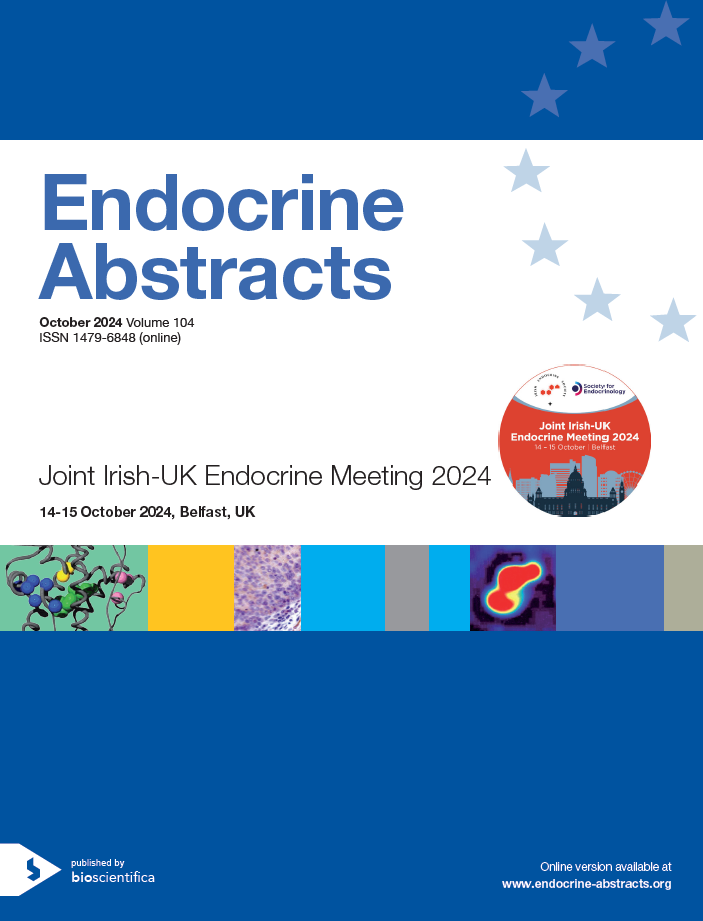
Joint Irish-UK Endocrine Meeting 2024
Belfast,
Northern Ireland
14 Oct 2024 - 15 Oct 2024

Poster Presentations
Thyroid
ea0104p200 | Thyroid | SFEIES24
Genetic proxied IL-12 p40 inhibition and risk of Grave’s ophthalmopathy: a mendelian randomization study
Zuckerman Benjamin , Warwick Alasdair
ea0104p201 | Thyroid | SFEIES24
Profile and management of thyroid disease in children and young people (CYP) attending type 1 diabetes (T1D) clinics in southern health and social care trust (SHSCT)
Campbell Geraldine , Nwaogu Nwaoma , Donnan Kate , Shah Shilpa , Millar Sarinda
ea0104p202 | Thyroid | SFEIES24
SVUH complex thyroid clinic 3 years on; enabling early diagnosis and management of rare forms of thyroid disease
Maher Sean , Ruddy Maria , Twomey Pat , Moran Carla
ea0104p203 | Thyroid | SFEIES24
Liothyronine prescribing at university hospitals of leicester NHS trust – audit (2nd cycle)
Al Jumaah Ali , Levy Miles , Gohil Shailesh , Reddy Narendra
ea0104p204 | Thyroid | SFEIES24
Simultaneous onset of addison’s disease and hyperthyroidism
Austin Isobel , Johnston Philip C.
ea0104p205 | Thyroid | SFEIES24
Selenium prescribing for thyroid eye disease in NI – the exponential rise
Aamir Shahzad Muhammad , Nugent Ailish , Hunter Amy , Lewis Anthony , Loughrey Ben , Ahmed Doua , Casey Geraldine , McHenry Claire , Courtney Hamish , Wallace Helen , Wallace Ian , Lindsay John , Darrat Milad , Johnston Philip , Haq Rizwan , D'Arcy Robert , Kamalarajah Sri , Hunter Steven , White Steven , Graham Una , McNabb Bernadette , McElwaine Fred , McMullan Paul , Harper Roy , Elhassan Samah , Shakeel Majeed Muhammad , Mustafa Shaikh Ghulam , Neely Andrew , Todd Anna , Sandhu Farooq , Smyth Jayna , Bradley Una , McConnell Mae , Kennedy Adele , Hameed Ali , Hamill Connor , Rooney Des , McKeever Edward , McCracken Emma , Black Neil , Kelly Rhys , Cartmill Barry , Bonanos Efstathios , Gordon Aileen , Woodside Jayne , Mullan Karen
ea0104p206 | Thyroid | SFEIES24
Thyroid function and antibody testing in patients receiving pegylated-interferon therapy
ea0104p207 | Thyroid | SFEIES24
Identifying risk factors for relapse in graves’ disease: a retrospective study
Blaibel Dania , Pappachan Joseph
ea0104p208 | Thyroid | SFEIES24
De novo thyroid eye disease following covid vaccination several years after radioiodine therapy
Mukunda Athira , James Jovito , Jacob Rhea , Varughese George I. , Nayak Ananth
ea0104p209 | Thyroid | SFEIES24
Incidental papillary thyroid microcarcinoma: implications of recurrence and survival on management recommendations
Finnegan Emma , Hintze Justin , Kinsella John , Louise Healy Marie
ea0104p210 | Thyroid | SFEIES24
The new anthropometric indices and atherogenic indices are correlated with lipid status after radioactive iodine treatment of graves disease
ea0104p211 | Thyroid | SFEIES24
A clinical audit of thyroid nodule management at galway university hospital
O'Brien Clare , Ryan Laura , Casey Mary , Young Orla , Bell Marcia
ea0104p212 | Thyroid | SFEIES24
Patients with graves’ disease have more severe biochemical thyrotoxicosis and develop higher rates of post radioiodine hypothyroidism than those with nodular disease
Yap Kai , Lim Annabelle , Imtiaz Arouba , Nalla Preethi , Witczak Justyna , Lansdown Andrew , Jones Elisabeth , Premawardhana Lakdasa
ea0104p213 | Thyroid | SFEIES24
If at first you don’t succeed, thy and thy again?
Burke Kevin , Martin Eoin , Ipadeola Olubunmi , Almezen May , Noctor Eoin , Bin Mahfooz Mohammed , Marie Hannon Anne , Melvin Audrey
ea0104p214 | Thyroid | SFEIES24
The occurrence of rheumatoid arthritis in young females with thyroid dysfunction condition in iodine deficient region
Kurambaeva Diyora , Shamansurova Zulaykho
ea0104p215 | Thyroid | SFEIES24
Thyroid dysfunction and large goitre in an adolescent with severe iodine deficiency due to dietary restrictions
Tellier Genevieve , Berkeley Rhiannon , Sayer Ghislaine , Bakare Rasheedat , Wilton Anthony
ea0104p216 | Thyroid | SFEIES24
Thyroid orbitopathy associated with primary hypothyroidism and anti-TSH receptor antibodies; clues from a functional TSH receptor bioassay
Nevin Dan , Hoashi Shu , Pazderska Agnieszka , Khan Rizwana , McGowan Anne , Healy Ultan
ea0104p217 | Thyroid | SFEIES24
Case report: a unique presentation of multiple cases of autoimmunity and follicular thyroid cancer
Maraj Rayanna , Bowers Kevin , Healy Marie-Louise
ea0104p218 | Thyroid | SFEIES24
The role of endocrine specialist nurses in the current NHS era
Hawkins Anna , Enriquez Nancy , Chan Carmela , Tanday Raj , Nikookam Khash
ea0104p219 | Thyroid | SFEIES24
Thyroid malignancy rate in U3 thyroid nodules
Al Busaidy Merah , Smith Diarmuid , Sherlock Mark , O'Reilly Michael , Wanic Krzysztof , Hill Arnold , O'Neill Paul , Morrin Martina , Dunne Ruth , Canning John , Ryan Cliona , Agha Amar
ea0104p220 | Thyroid | SFEIES24
A case of uncontrolled graves’ disease causing cerebral venous sinus thrombosis
Kelly James , Marnane Mitchell , Ludgate Stephen , Gibney James , Garrahy Aoife , McGowan Anne



